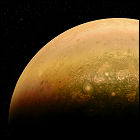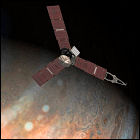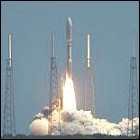Juno: close, but no science
 NASA’s Juno space probe makes a third close swing past Jupiter, but engineering problems make it a blind pass: concerns over stuck valves in the engine leads ground controllers to cancel a planned engine burn to shorten the length of Juno’s orbit, and then mere hours before its latest close pass, Juno goes into a safe mode which shuts down all instruments and cameras pending intervention from Earth. Juno principal investigator Scott Bolton assures that Juno could, theoretically, complete its mission with longer, unadjusted orbits if need be; Juno’s next close pass by Jupiter is expected to happen in December, impacting all future events in the mission plan.
NASA’s Juno space probe makes a third close swing past Jupiter, but engineering problems make it a blind pass: concerns over stuck valves in the engine leads ground controllers to cancel a planned engine burn to shorten the length of Juno’s orbit, and then mere hours before its latest close pass, Juno goes into a safe mode which shuts down all instruments and cameras pending intervention from Earth. Juno principal investigator Scott Bolton assures that Juno could, theoretically, complete its mission with longer, unadjusted orbits if need be; Juno’s next close pass by Jupiter is expected to happen in December, impacting all future events in the mission plan.
Juno gets up close and personal with Jupiter
 NASA’s Juno spacecraft completes its first orbit of giant planet Jupiter with an orbit-shaping manever that takes it as close to Jupiter’s cloudtops as 2,600 miles – less than the width of the continental United States – at a speed of over 100,000 miles per hour. Juno obtains the first close-up views of the north and south poles of the planet, revealing a roiling hotbed of storm activity unlike the poles of relatively quiet Saturn. In addition to photos, Juno scans the planet in the infrared and ultraviolet portions of the spectrum. This is scheduled to be Juno’s closest flyby of its entire mission.
NASA’s Juno spacecraft completes its first orbit of giant planet Jupiter with an orbit-shaping manever that takes it as close to Jupiter’s cloudtops as 2,600 miles – less than the width of the continental United States – at a speed of over 100,000 miles per hour. Juno obtains the first close-up views of the north and south poles of the planet, revealing a roiling hotbed of storm activity unlike the poles of relatively quiet Saturn. In addition to photos, Juno scans the planet in the infrared and ultraviolet portions of the spectrum. This is scheduled to be Juno’s closest flyby of its entire mission.
Juno arrives at Jupiter
 NASA’s Juno space probe successfully pulls of a risky orbital insertion maneuver, slowing itself down just enough to be captured into an unprecedented polar orbit around Jupiter. Launched in 2011, Juno’s first close pass of Jupiter brings it within 3,100 miles of Jupiter’s cloudtops, the closest any spacecraft has ever approached the huge planet. Its polar orbit will allow it to reduces its exposure to Jupiter’s intense magnetic field, which is powerful enough in the planet’s equatorial regions to damage or destroy on-board electronics. Juno’s mission is expected to last 20 months.
NASA’s Juno space probe successfully pulls of a risky orbital insertion maneuver, slowing itself down just enough to be captured into an unprecedented polar orbit around Jupiter. Launched in 2011, Juno’s first close pass of Jupiter brings it within 3,100 miles of Jupiter’s cloudtops, the closest any spacecraft has ever approached the huge planet. Its polar orbit will allow it to reduces its exposure to Jupiter’s intense magnetic field, which is powerful enough in the planet’s equatorial regions to damage or destroy on-board electronics. Juno’s mission is expected to last 20 months.
Juno visits home one last time
 Bound for planet Jupiter in 2015, the unmanned space probe Juno swings past Earth to catch a gravity assist boost from its home planet. Launched in 2011, Juno slips past Earth at a distance of only 350 miles, boosting its speed to 93,000 miles per hour relative to the sun, fast enough to cross the distance between Earth and its moon in three hours (by comparison, the Apollo manned missions of the 1960s took three days to make that trip). But as it comes out of Earth’s shadow, Juno goes into a failsafe mode to protect the spacecraft against an unanticipated fault. Juno is brought back online within two days as it continues on the final leg of its flight to Jupiter.
Bound for planet Jupiter in 2015, the unmanned space probe Juno swings past Earth to catch a gravity assist boost from its home planet. Launched in 2011, Juno slips past Earth at a distance of only 350 miles, boosting its speed to 93,000 miles per hour relative to the sun, fast enough to cross the distance between Earth and its moon in three hours (by comparison, the Apollo manned missions of the 1960s took three days to make that trip). But as it comes out of Earth’s shadow, Juno goes into a failsafe mode to protect the spacecraft against an unanticipated fault. Juno is brought back online within two days as it continues on the final leg of its flight to Jupiter.
Juno to Jupiter!
 NASA launches the unmanned Juno space probe on its way to Jupiter, on a trajectory that will accelerate the vehicle through a series of maneuvers, including a gravity assist pass of Earth, en route to Jupiter. Once it arrives at the solar system’s largest planet, Juno will enter a polar orbit to monitor the planet’s clouds and magnetic field over a period of one year beginning in 2016. Juno is solar-powered, without the customary nuclear power source that has been a feature of all previous outer solar system missions. Since it will spend time within the heaviest area of Jupiter’s magnetosphere, Juno’s components are built into a hexagonal structure which acts as a heavy-duty Faraday cage to block out the radiation trapped within Jupiter’s magnetic field.
NASA launches the unmanned Juno space probe on its way to Jupiter, on a trajectory that will accelerate the vehicle through a series of maneuvers, including a gravity assist pass of Earth, en route to Jupiter. Once it arrives at the solar system’s largest planet, Juno will enter a polar orbit to monitor the planet’s clouds and magnetic field over a period of one year beginning in 2016. Juno is solar-powered, without the customary nuclear power source that has been a feature of all previous outer solar system missions. Since it will spend time within the heaviest area of Jupiter’s magnetosphere, Juno’s components are built into a hexagonal structure which acts as a heavy-duty Faraday cage to block out the radiation trapped within Jupiter’s magnetic field.